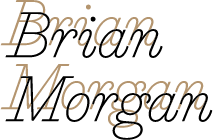TWO ARTISTS
Jessica Eaton
For sixteen years the German poet Johann Wolfgang von Goethe patiently investigated colour, observing the effects of afterimages and of the spectral colours produced by heating polished metal plates or trapping condensation between sheets of glass. His experiments broke new ground in the study of the phenomenology of colour, and his 1810 Theory of Colours inspired physiologists and colour theorists and was widely read at the Bauhaus. "Colour is a deception," proclaimed one of these readers, the German painter and teacher Joseph Albers. "In visual perception colour is almost never seen as it really is—as it physically is."
As Albers and his Bauhaus colleague Johannes Itten demonstrated, the same colour can be perceived as different, depending on the colour beside it. There are a number of reasons for this, but the principal one, as the neurologist Mark Changzi has argued, is that our eyes are tuned to the colour of human skin, to allow us to discern things like the emotions and health of others; a good deal of our perception of colour outside of this is contextual. It's this complexity, and the potential emotional power of colour, that makes it an interesting field for investigation.
It’s a field that Regina-born and Vancouver-educated Jessica Eaton is also patiently mining. In her series Cubes for Albers and Lewitt she explores these and other optical phenomena by repeatedly (and carefully) shooting grey cubes onto the same 4 x 5" or 8 x 10" negative, using different gels and different exposures. “I started working with the tri-colour process in 2004 or so, having found it in an old Kodak photography manual,” she has said. The results are extremely rich. But why shoot these cubes, why not make them? The camera captures little imperfections—life, as it were—and proceeding from nature allows for unexpected discoveries.
Another thread which is important in Eaton's work is an indifference to representation. Abstraction is inherent in the medium of photography: it is only by the act of framing that we get the "recognizable" image. If the photographer shoots not you but the ground on which you’re standing you get abstraction. Or, another form of representation. Some of Henry Fox Tablot's first images were of objects placed onto treated paper, and this idea was taken up later by Man Ray and László Moholy-Nagy. But while these later experiments were being conducted at the same time as the rise of abstraction in art, photography came to abstraction on its own terms. "What light does, a photograph is, and we can see an image only at behest of impeded light,” wrote the critic Lyle Rexer. What Eaton is doing, in effect, with gels and multiple exposures, is carefully and fully exploring this impedance. And like all research, it is in the slips and accidents from which real advances are made: these she has described as “photographs I wasn’t able to see before they existed.”
Raymond Boisjoly
In the summer run-up to the 2010 Olympics, carver Robert Yelton floated a suggestion, taken up by the chief of the Squamish First Nation, to rename Vancouver's Stanley Park Xwáyxway, after the village that used to occupy the site. The public reaction was sadly predictable: the idea was quickly dismissed, and many reactions were laced with ignorance and racism. What was not predictable was Raymond Boisjoly's riposte. His series Writing Lesson was a sharp, economical satire in which he rendered familiar aboriginal place names, such as Nanaimo, Spuzzum, and Chilliwack, in a visual grammar that internet trolls might find more acceptable, that of Norwegian Black Metal. Members of this movement may have won the Eurovision song contest, but they were also implicated in the burning of medieval stave churches because they sat on the sites of former pagan shrines. Even now you can buy a candle cast in the shape of the first church that was set alight.
In their rascally way, the Dadaists, and their cousin Marcel Duchamp, opened up new possibilities for art. The notion they hatched—that the idea, not the form, should have primacy, has since become somewhat conventional. Many Vancouver artists, such as the N.E. Thing Co., Rodney Graham, Brian Jungen, Steven Shearer, and Mafawny Macleod, have taken up this ideas-first model with, as others have observed, humour and erudition, coherence and eclecticism. Still, it’s worth remembering the form’s revolutionary roots: whatever they did, the artists who presented the Cabaret Voltaire in 1915 were using cathartic satire to point out the absurdity of the slaughter taking place all around safe, neutral Switzerland; in fact they found themselves in Zurich because of it.
The son of a Haida mother and a Quebecois father, Boisjoly finds himself at the boundary between their two worlds. In a sense he’s a translator, compassionately presenting the complexities of contemporary aboriginal experience in a form that is firmly rooted in the present-day. This seems to parallel the literary critic Craig S. Womack's call for criticism that is loving, imaginative, and grounded in material reality. His is also an art that thinks. These tendencies are visible in his series an other cosmos. Here the Northwest Coast formline is laid over top of images from the Hubble telescope, the latter a reference to the cosmic album art of the band Parliament Funkadelic, who espoused an inclusive take on Afrofuturist notions of black space travel and liberation.
From The Walrus, December 201. Edited by Sasha Chapman.
